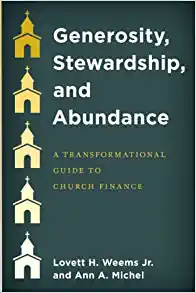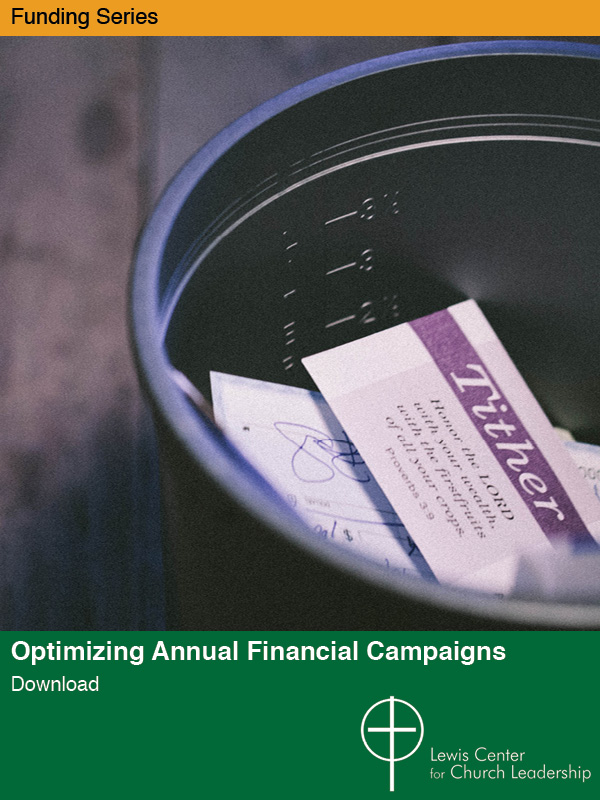Ann A. Michel and Lovett H. Weems Jr., authors of Generosity, Stewardship, and Abundance, say creating a culture of generosity requires creativity and consistency. They outline seven strategies that any church can deploy to deepen the link between faith and giving.
The church’s task in inspiring generosity isn’t merely one of persuasion or education. Like other aspects of faith, generosity is more often caught than taught. While preaching and teaching are essential in shaping expectations regarding giving, cultivating generosity is more often a matter of helping people to learn by doing. The practice of transformative, biblical generosity is nurtured within a robust culture of generosity reflected in every aspect of congregational life. Shaping such a culture requires creativity and consistency. Every congregation can take steps to begin to nurture a culture of generosity.
1. Use the offering as a teaching moment.
Each and every week, the time of offering provides a natural opportunity to teach the theology of giving and to inspire generosity. What happens during the collection in your worship service? Is it a joyful, exuberant time? Or is the plate passed so quickly and quietly that it projects a sense of embarrassment or distaste? What you speak, sing, and pray during the collection powerfully shapes your congregation’s mindset about giving. Take the opportunity each week to educate congregants on how offerings are used to the glory of God by naming specific ministries funded by the church. Prayers dedicating the offering should communicate a genuine and compelling sense of gratitude and opportunity in our call to give.
2. Exercise the vocabulary of generosity.
Congregations with strong cultures of generosity saturate their preaching, prayers, and worship with references to God’s generosity, gratitude, and giving as an act of faith. Week in and week out, they use a vocabulary that helps congregants understand the connection between faith and generosity — not just during the offering, not just on Sunday mornings, but using the lens of gratitude and generosity to frame every aspect of congregational life. Building a culture of generosity means finding ways to preach about money, giving, and stewardship throughout the year — not just in the one annual “Stewardship Sermon.” Preaching and teaching on stewardship only in conjunction with an annual stewardship appeal allows congregants to dismiss it as mere fundraising. They will be more open to hearing it at other times of the year.
3. Tell the story.
Congregations with strong cultures of generosity make a point of telling people about the good that comes about as a result of giving. They share success stories. They illustrate how generosity propels their mission. Churches take their givers for granted when they simply assume people understand these connections. Think about all the different ways you might share the good news of how your church uses people’s gifts. Newsletter articles. Thank you letters. Testimonies. Mission moments. Social media. YouTube videos. Web postings. And churches that mail out quarterly or annual giving summaries should never let those envelopes drop into the mailbox without including a thank you letter and an attractive one-pager illustrating, “Your Gifts at Work.”
4. Offer testimonies.
People speaking from the heart about why they give and the joy it engenders powerfully shape a culture of generosity. Yet in so many churches, a conspiracy of silence around money blocks this type of witness. Think how much we could learn from one another if we heard from young people and older people, big givers and more modest givers, longtime givers and those just beginning. Think about the possible venues for testimonies besides worship. They could be shared in small groups, in newsletters, or in videos posted to a church website. They could be part of the ongoing life of a church, not just part of a stewardship campaign. Allowing this type of testimony to shape a culture of generosity pierces the veil of secrecy around money and giving by fostering more authentic and transparent conversations. Pastors and other leaders can play a significant role in modeling this type of transparency by sharing their own giving testimonies.
5. Say thank you.
Gratitude and generosity are two sides of the same coin. Saying thank you promptly and regularly is one of the simplest and most effective things a congregation can do to reinforce a sense of gratitude and enhance giving. When people are thanked regularly, they feel appreciated, valued, and needed — which makes them more likely to support ministry with their time, talents, and financial support. Take stock of the various opportunities you have to express gratitude to your contributors — when someone gives to the church for the first time, when someone makes or fulfills a pledge, when giving statements are mailed out, or when a special gift is made. Then, make a plan for saying thank you in appropriate ways at these various junctures. A well-thought-out thank you system instills gratitude and reinforces generosity.
6. Teach about giving during Advent and Christmas.
Because holiday gift-giving is so deeply engrained in secular culture, Christmas is a logical time for the church to teach about generosity. Some churches have adopted the slogan “Christmas is not your birthday” and challenge families to give to worthy causes the equivalent of what they spend on one another. Other churches give all the offerings received at Christmas to a cause beyond their church. This models generosity and demonstrates the church’s commitment to mission. At Christmastime, the church also has an obligation to help people see the lure of consumerism and point them to more genuine expressions of love and generosity.
7. Involve children and youth.
If a toddler has ever crammed a soggy Cheerio into your mouth, you know that even babies are wired for generosity. Children of all ages understand the simple message that we have received much from God and God wants us to be generous in return. Emphasizing generosity in ministry with children not only prepares a future generation of givers, but it helps form parents and families as well because adults often pay extra attention to what their children are taught. The same is true for youth. When youth are responsible for raising funds to support their own programs and mission activities, it builds a sense of ownership and gets others enthused about giving. Make sure children and youth are given the opportunity to participate in the offering in a meaningful and appropriate way. And remind parents that their participation in the offering is a teachable moment for their children.
 This article is excerpted from Generosity, Stewardship, and Abundance: A Transformational Guide to Church Finances (Rowman and Littlefield, 2021) by Lovett H. Weems Jr. and Ann A. Michel. This book is available at Cokesbury, Rowman & Littlefield, and Amazon. Used by permission.
This article is excerpted from Generosity, Stewardship, and Abundance: A Transformational Guide to Church Finances (Rowman and Littlefield, 2021) by Lovett H. Weems Jr. and Ann A. Michel. This book is available at Cokesbury, Rowman & Littlefield, and Amazon. Used by permission.
Related Resources
- 7 Ways to Make it Easier to Talk about Money in Church by Ann A. Michel
- Giving for the Right Reasons by Saving Grace
- 5 Habits Your Church Must Unlearn to Increase Giving by Matt Miofsky and Jason Byassee






